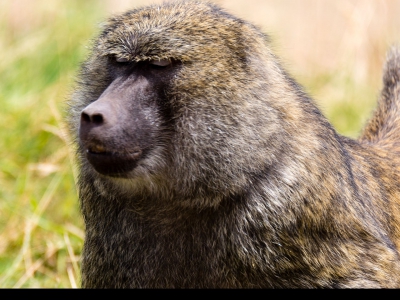Olive baboon Papio anubis
Animals in our sanctuary
Robert (Male)

He was seized in a Belgian pub where he stayed in a much too small cage. In the pub he had to do tricks and received a pint of beer as a compensation. He was taken care of by the Opglabeek Nature Aid Center. Papers were not present. The animal was originally to come from a zoo. Robert missed a piece of his tail and his teeth were very bad: he had some broken teeth. Robert had little confidence. Fortunately, he came to the AAP Foundation under the care of a maternal yellow baboon. She raised him and made what you call "a man of him." Now Robert has grown into a beautiful green baboon who manages the females Andrea, Lucy and Marta and the younger male Gene.
Gene (Male)

Gene was seized near Venlo. He was purchased from a laboratory animal trader from a shipment intended for an animal laboratory. He was housed in a large barn / stable in a cage of barely 7 x 3 meters, with a concrete floor without ground cover and with a single perch. Horse boxes were also built in this barn, some of which had been used as cages for lynxes (these had since also been seized). There were also countless native and exotic birds. The whole barn had an atmosphere of trade, although it was stated that the animals had been purchased for private animal use from the former owner. Strange.
Lucy (female)

Lucy was a circus animal in Germany and until recently performed regularly, among other things, she rode a horse during her performance. Due to changed rules, the owner of the Veterinärambt was no longer allowed to let her perform. Lucy was registered as an informal baboon, but a check showed that Lucy was not an informal baboon; she probably had fake CITES documents from another animal. This raises doubts about her age. Her origin could possibly be wild catch. She has now been completely at ease in the group for years.
Roco (Male)

Roco was found among rubbish in Spain by the Guardia Civil.
Alejandrita (female)

Alejandrita was seized by the Guardia Civil in a Spanish pet shop.
Lalita (female)

Lalita was seized from a French circus, thanks to some alert animal lovers.
Kaki (Male)
.jpg)
Kaki was kept by a circus. He had not left his cage in three years and for the last two years of that, he was also completely alone after the death of his female partner. The circus relinquished Kaki after the owner fell seriously ill with cancer.
Tyna (female)

Tyna came from a zoo where there was no more room for her. Despite being a different species, she plays a key role in the group of green baboons she was joined with at Stichting AAP.
Where does he feel most at home?
They live on the savannahs, steppes, forests and rocky areas of Central Africa. Their habitat is still growing.
What's his favourite food?
The green baboon is an omnivorous opportunist, searching for food both on the ground and in trees. He mainly eats grass, buds, leaves and fruit, supplemented with resin, gum and grasshoppers and other insects. He also eats small vertebrates, from lizards to young antelopes, and roots and blossoms. He easily adapts his diet.
Fun fact
Because some tail bones have grown together, there is a kink in the tail. This makes it seem like the tail is broken.
Adopt this Olive baboon


.jpg)
.jpg)
.jpg)
.jpg)